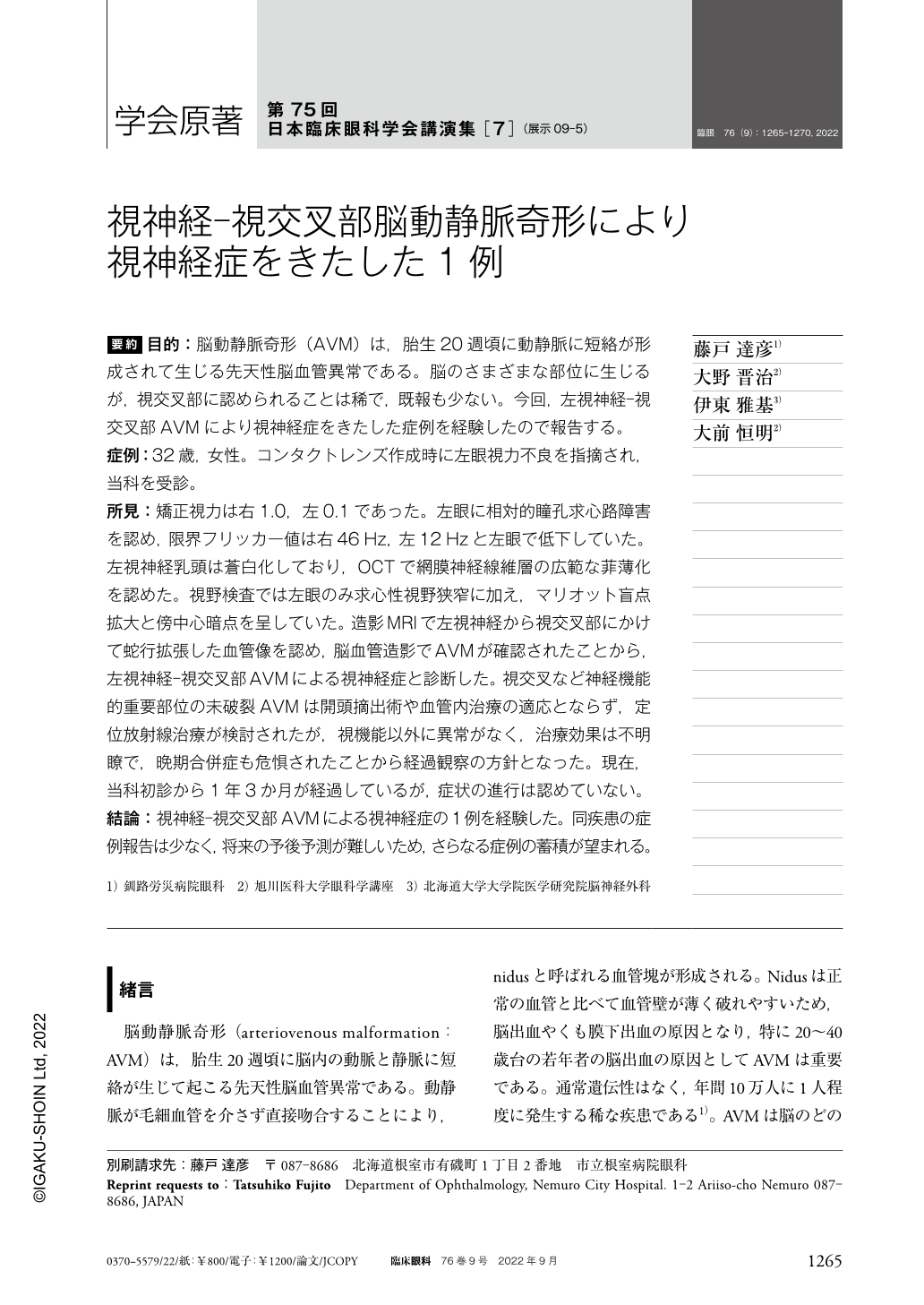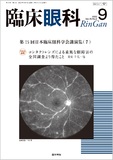Japanese
English
- 有料閲覧
- Abstract 文献概要
- 1ページ目 Look Inside
- 参考文献 Reference
要約 目的:脳動静脈奇形(AVM)は,胎生20週頃に動静脈に短絡が形成されて生じる先天性脳血管異常である。脳のさまざまな部位に生じるが,視交叉部に認められることは稀で,既報も少ない。今回,左視神経-視交叉部AVMにより視神経症をきたした症例を経験したので報告する。
症例:32歳,女性。コンタクトレンズ作成時に左眼視力不良を指摘され,当科を受診。
所見:矯正視力は右1.0,左0.1であった。左眼に相対的瞳孔求心路障害を認め,限界フリッカー値は右46Hz,左12Hzと左眼で低下していた。左視神経乳頭は蒼白化しており,OCTで網膜神経線維層の広範な菲薄化を認めた。視野検査では左眼のみ求心性視野狭窄に加え,マリオット盲点拡大と傍中心暗点を呈していた。造影MRIで左視神経から視交叉部にかけて蛇行拡張した血管像を認め,脳血管造影でAVMが確認されたことから,左視神経-視交叉部AVMによる視神経症と診断した。視交叉など神経機能的重要部位の未破裂AVMは開頭摘出術や血管内治療の適応とならず,定位放射線治療が検討されたが,視機能以外に異常がなく,治療効果は不明瞭で,晩期合併症も危惧されたことから経過観察の方針となった。現在,当科初診から1年3か月が経過しているが,症状の進行は認めていない。
結論:視神経-視交叉部AVMによる視神経症の1例を経験した。同疾患の症例報告は少なく,将来の予後予測が難しいため,さらなる症例の蓄積が望まれる。
Abstract Purpose:Cerebral arteriovenous malformation(AVM)is a congenital vascular abnormality caused by intracranial arteriovenous shunt at about 20 weeks of gestation. It occurs in various parts of the brain, but is rarely found in the optic chiasm. Here, we report a case of optic neuropathy caused by an AVM on the left optic nerve extending to the optic chiasm.
Case:A 32-year-old female was pointed out that her left eye had deterioration of eyesight when trying to make contact lenses, and she visited our department.
Findings:The patient presented best corrected visual acuities of 20/20 in the right eye and 20/200 in the left eye. Relative afferent pupillary defect was observed in the left eye. The critical flicker fusion frequency was decreased in the left eye(right eye 46 Hz, left eye 12 Hz). The fundus examination showed left optic disc pallor, and the optic coherence tomography image visualized extensive thinning of the retinal nerve fiber layer. Goldmann perimetry testing showed that the left eye exhibited concentric contraction of visual field, enlargement of the blind spot of Mariotte, and paracentral scotoma. Contrast-enhanced magnetic resonance imaging showed a tortuous and dilated blood vessels on the left optic nerve extending to the optic chiasm, and cerebral angiography confirmed AVM. Unruptured AVM in the eloquent area, including optic nerve/chiasm, is not usually indicated for interventional treatment, including microsurgical resection, endovascular embolization. While stereotactic radiosurgery was considered, a conservative wait-and-see approach was selected because there were no abnormalities other than visual function, the therapeutic effect was unclear, and late complications of the radiotherapy was feared. Currently, one year and three months have passed since the first visit to our department, and no symptom progression has been observed.
Conclusion:We have reported our experience of optic neuropathy due to optic chiasm AVM. As there are few case reports of this condition and it is difficult to predict the natural course, further accumulation of similar cases is warranted.

Copyright © 2022, Igaku-Shoin Ltd. All rights reserved.


